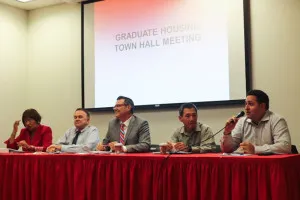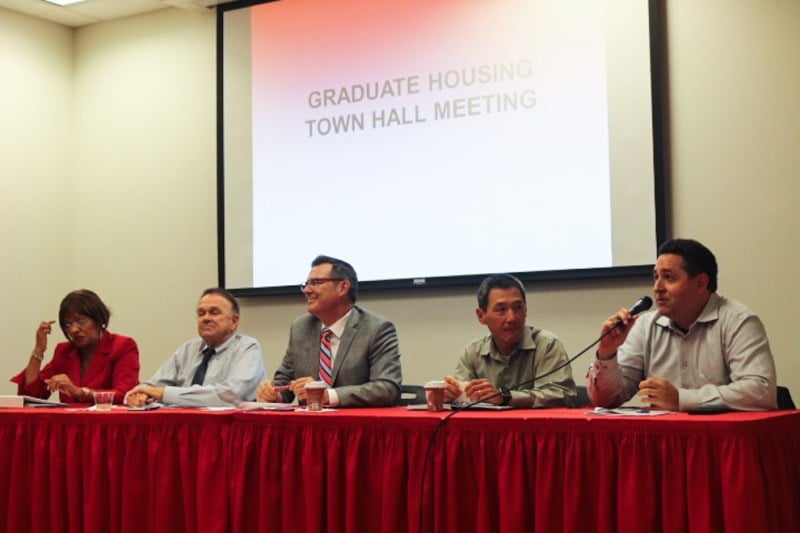
Graduate students with families and administrative members of the Student Housing division of Residential & Dining Enterprises (R&DE) met to discuss a construction project in Escondido Village in a town hall last Friday. Hosted by the R&DE, the meeting addressed the creation of new single graduate housing units in place of existing graduate family courtyard homes.
This project comes in light of a critical need for graduate student housing. Statistics from the R&DE 2015-2016 graduate housing lottery show that of 6,344 graduate students that applied for housing, 1,414 were not assigned a unit. Of those graduate students not assigned housing, 21 were families with children, 207 were couples without children, and 1,186 were single students.
According to vice provost of R&DE Shirley Everett, who presided over the meeting, this project will create 2,400 new graduate housing spaces at the cost of demolishing 400 spaces. This will create a net gain of 2,000 graduate living spaces primarily for singles.
Graduate housing units contain multiple living spaces, depending on the number of family members or roommates that live with each student.
The project would demolish 182 existing graduate family courtyard units in Escondido Village, according to the Student Housing powerpoint presented at the town hall meeting. Of the 426 current units, only 244 would remain after the proposed construction project.
“Our goal is to build graduate housing that takes into account the needs of our singles and couples while preserving housing for families in Escondido Village,” Everett said.
According to Everett, R&DE plans to house 75 percent of graduate students with the new development.
A Stanford News article from October said the new construction would likely be multi-story complexes built in the area of the Hoskins, Thoburn, McFarland and Hulme courts along Serra Street in Escondido Village.
The sudden notice
Many graduate students expressed discontent over the short notice Student Housing gave graduate student families in Escondido Village to secure their own housing during construction.
Luke Raymond, an electrical engineering graduate student, shared his frustration at the meeting about receiving a move-out notice in June, giving him only three months to relocate.
“I can’t think of another rental situation or contract, outside of something strange, where three months is sufficient [notice to move out],” Raymond said. “I even have to tell Stanford that I will be living in Escondido Village over six months ahead of time.”
Rodger Whitney, executive director of Student Housing, responded to Raymond’s question during the Q&A portion of the town hall by highlighting the recent origin of the construction plan.
“It’s really been on people’s minds for two to three months with an opportunity that allowed us to look at this as a potential problem [before] taking it to the Board of Trustees,” Whitney said.
Student relocations
Students also voiced concerns about relocations as a result of the construction plans. Everett responded that graduate families whose current houses will be impacted by the construction will be relocated to other family housing areas within Escondido Village.
Everett also wrote in an email to The Daily that many single students currently living in Escondido Village family courtyard housing affected by construction will be relocated to single graduate student housing locations after the project.
She explained why Escondido Village was chosen as the construction site for single graduate units.
“Stanford prioritizes the preservation of open space and intentionally uses available space in areas already developed,” Everett said. “[Stanford] rebuilds [housing units] with greater density and improved land use … to help house more students on campus.”
According to Everett, denser housing units will also help families impacted by the project relocate to other family courtyards.
Zacharia Rodgers, a management science and engineering Ph.D. student who is living with his spouse and children in Escondido Village, spoke on behalf of graduate students about the effectiveness of these plans in an interview with The Daily after the meeting.
“The current project would break housing for one set of students to fix housing for another,” Rodgers said. “None of us want housing at the expense of each other.”
“Many of us grad families want to emphasize that the graduate single and couple housing shortages absolutely must be fixed,” he later added in an email. “We are pleading with administration not to break family housing in the process!”
Loss of outdoor courtyards
Concerns were also raised about how the project would affect the family-friendly outdoor courtyards in Escondido Village, which have become a traditional staple of that graduate community over the years.
“The new arrangement destroys a little bit of the community we have,” one student said during the meeting. “In the future, what are some flexibility options we can create to have a courtyard atmosphere in those [housing units for graduate families]?”
According to Rodgers, many families were frustrated that they were not consulted during the process of deciding the construction site.
“We have community because we have courtyards,” Rodgers said. “It’s wonderful to come home and to have so much friendship with our courtyard neighbors. Our kids have friends, we have friends … The love that’s there is incredible.”
Additionally, Rodgers wondered why R&DE planned to take out the courtyards when other building options are available.
“People are choosing between Stanford and other elite schools,” Rodgers said. “[Courtyard communities] are the reason family students come here.”
Moving forward
The town hall meeting concluded with board members of Student Housing arranging for future weekly meetings with graduate families in light of tentative construction plans. Meetings will also be held with the Graduate Student Council and Graduate Housing Advisory Committee, according to Everett.
“Over the coming weeks and months, we will continue to engage graduate students to identify and address their concerns about this project and to solicit their suggestions for design and amenities that will meet the needs of all the residents of this community,” Everett said in an email to The Daily.
Administrators at the town addressed proposed plans to smooth this transition, including creating committees to address the issues.
“Moving forward, I think all of us students would like to see solutions from the administration that preserve the family housing community while creating much-needed housing for single and couple students,” Rodgers said.
Whitney addressed this sentiment by saying that R&DE would recreate the existing family courtyard atmosphere after construction.
“We will recreate the amenities and the programs and the courtyards and the playgrounds … the way [graduate families] have [these amenities] exactly right now,” Whitney said during the Q&A.
Students also asked about the finality of the plans, particularly the destruction of the outdoor courtyards.
“Remember, this [construction project] is still conceptual,” Everett said. “When we have a plan like this, there are lots of stakeholders … So, when we say conceptual, we mean it.”
Contact Stefan Lacmanovic at stefanl ‘at’ stanford.edu
An earlier version of this article incorrectly stated that the town hall was hosted by the Graduate Student Council Housing Committee, a body that does not exist. The town hall was organized by R&DE.
